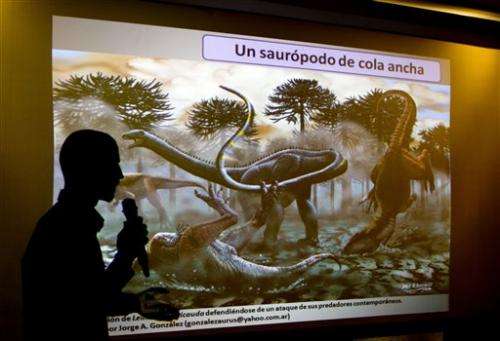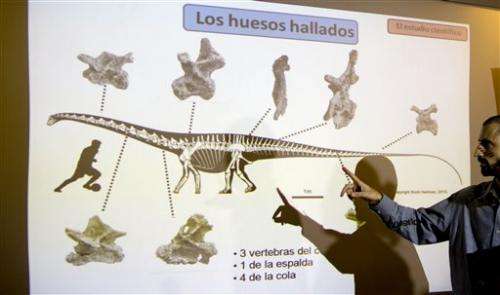Argentine dino find: long-necks survived Jurassic (Update)

Dinosaur fossils found in Patagonia provide the first evidence that long-necked, whip-tailed diplodocid sauropods survived well beyond the Jurassic period, when they were thought to have gone extinct, Argentine paleontologists said Thursday.
Pablo Gallina, a researcher at Buenos Aires' Maimonides University, described the find as the first definitive evidence that diplodocids reached South America, and the most recent geologic record of this branch of sauropod anywhere.
"It was a surprise, because the first remains we found were very deteriorated and we didn't think much of them, but later through careful laboratory work, cleaning rock from the bones, we could see that they were from a diplodocid, something unthinkable for South America."
Gallina's team says the fossils show that diplodocids roamed South America during the early Cretaceous era, well after scientists thought these kinds of dinosaurs became extinct. They also suggest that the diplodocid clade, or family group, evolved from other dinosaurs before the Earth's continents split apart, which is earlier than previously thought.
"Diplodocids were never certainly recognized from the Cretaceous or in any other southern land mass besides Africa," the authors wrote. "The new discovery represents the first record of a diplodocid for South America and the stratigraphically youngest record of this clade anywhere."
Explaining the find a day after the conclusions were published in the PLOS ONE scientific journal, they said the eight vertebrae they recovered belong to a new species they named "Leinkupal laticauda." That's a combination of native Mapuche words for "vanishing" and "family," and Latin words for "wide" and "tail."

The remains were found in rocky outcrops of the "Bajada Colorada," a Cretaceous-era formation south of the town of Picun Leufu in Neuquen province.
Paleobiologist Paul Upchurch at University College London, a sauropod expert who was not involved in the study, said it suggests that not all diplodocids succumbed to a mass extinction about 140 million years ago at the end of the Jurassic period.
"Here's evidence that one or two groups got through. Rather than a total extinction, that it was devastating, but it didn't completely kill them off," Upchurch said.
As for the conclusion that the South American find shows diplodocids evolved from a common ancestor earlier than previously thought, Upchurch said "there's certainly a possibility that this would push the origin back a bit," given that Africa and South America separated during the Jurassic period.
Another expert, paleontologist John Whitlock of Mount Aloysius College in Pennsylvania, also lauded the finding.
"A discovery like this is more than just another data point. It's a chance to re-evaluate our understanding of how the group spread across the globe through time," he said.
"We can use that information to do things like examine how dinosaurs might have chased their preferred environment around the globe as the climate changed, and that's the sort of research with direct implications for those of us around today."
The research was partly funded by The Jurassic Foundation, formed by producers of the Jurassic Park films. Sebastian Apesteguia, paleontology director at Maimonides University, noted that the characters in Jurassic Park II ride a motorcycle under a diplodocid's legs.
"Until now the diplodocids were thought to be North American dinosaurs. They were the classic dinosaurs from all the Hollywood movies," he said.
More information: Gallina PA, Apesteguía S, Haluza A, Canale JI (2014) A Diplodocid Sauropod Survivor from the Early Cretaceous of South America. PLoS ONE 9(5): e97128. DOI: 10.1371/journal.pone.0097128
Journal information: PLoS ONE
© 2014 The Associated Press. All rights reserved.




















